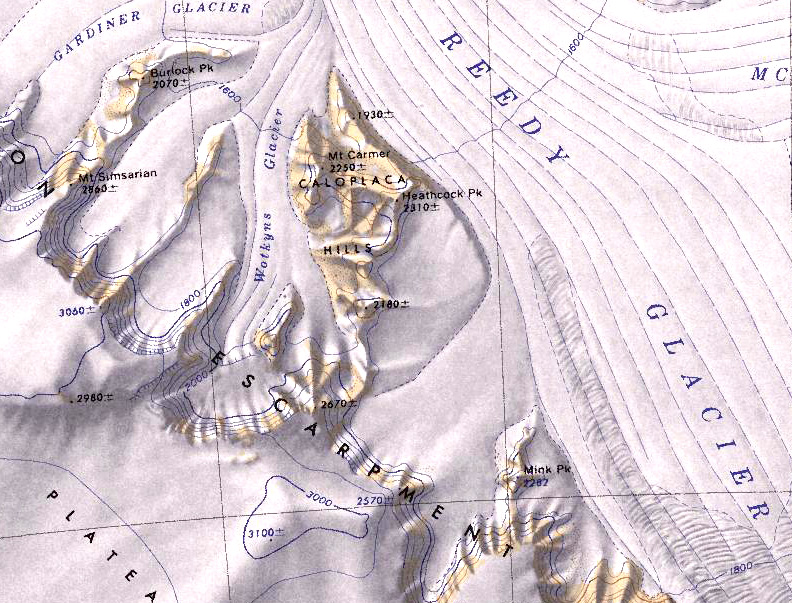Difference between revisions of "Caloplaca Hills"
Westarctica (talk | contribs) (Created page with "350px|thumb|Map showing the Caloplaca Hills The '''Caloplaca Hills''' (86°7′S 131°0′W) are a distinctive group of rock hills including Mount...") |
Westarctica (talk | contribs) |
||
| (One intermediate revision by the same user not shown) | |||
| Line 1: | Line 1: | ||
[[File:Caloplaca-Hills.jpg|350px|thumb|Map showing the Caloplaca Hills]] | [[File:Caloplaca-Hills.jpg|350px|thumb|Map showing the Caloplaca Hills]] | ||
The '''Caloplaca Hills''' (86°7′S 131°0′W) are a distinctive group of rock hills including Mount Carmer and Heathcock Peak, lying east of the [[Watson Escarpment]] on the west side of [[Reedy Glacier]]. | The '''Caloplaca Hills''' (86°7′S 131°0′W) are a distinctive group of rock hills including [[Mount Carmer]] and [[Heathcock Peak]], lying east of the [[Watson Escarpment]] on the west side of [[Reedy Glacier]]. | ||
==Discovery and name== | ==Discovery and name== | ||
The hills were mapped by the United States Geological Survey from surveys and from [[United States Navy]] aerial photographs collected during the years 1960–64. The name was suggested by J.H. Mercer of the Institute of Polar Studies at Ohio State University, after ''Caloplaca'', the type of [[lichen]] found here. | The hills were mapped by the United States Geological Survey from surveys and from [[United States Navy]] aerial photographs collected during the years 1960–64. The name was suggested by J.H. Mercer of the Institute of Polar Studies at Ohio State University, after [[Caloplaca saxicola|''Caloplaca'']], the type of [[lichen]] found here. | ||
==Features== | |||
* [[Mount Carmer]] | |||
* [[Heathcock Peak]] | |||
[[Category:Geography of Westarctica]] | [[Category:Geography of Westarctica]] | ||
Latest revision as of 04:18, 6 May 2024
The Caloplaca Hills (86°7′S 131°0′W) are a distinctive group of rock hills including Mount Carmer and Heathcock Peak, lying east of the Watson Escarpment on the west side of Reedy Glacier.
Discovery and name
The hills were mapped by the United States Geological Survey from surveys and from United States Navy aerial photographs collected during the years 1960–64. The name was suggested by J.H. Mercer of the Institute of Polar Studies at Ohio State University, after Caloplaca, the type of lichen found here.
